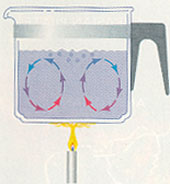
Mantle Convection
Convection is the most efficient type of heat transport mechanism. It is commonly observed in many natural settings, and is most likely the way in which heat is transported from the interior of the Earth.
 |
We all have seen convection before. Everytime we cook a pot of water, for example, convection occurs. At the left we see a picture of a pot of water that is heated from below. The water close to the flame (heat source) heats up (red arrows) and rises because it expands and has lower density, then the water releases heat as cools down at the top (blue arrows) and sinks down again. Basically, the moving (circulating) water is a conveyor belt for heat transport from the hot flame to the cooler surface. |
 |
Geologists envision that heat transport between the planet core and surface is accomplished analogous to our hot water convection. The mantle is heated from below (the core), and in areas that are hotter it rises upwards (it is buoyant), whereas in areas that are cooler it sink down. This results in convection cells in the mantle, and produces horizontal motion of mantle material close to the Earth surface. This convection takes place in mantle rock (a mixture of silicate minerals) that at any given time would appear solid to us. Yet, when the forces of buoyancy are applied over millions of years, this seemingly solid material does move after all. It behaves like an extremely viscous fluid and "creeps" along slowly. Also, in the uppermost portions of the mantle, the pressure - temperature conditions are such that a small fraction (a few percent) of the material is probably in the molten state. Thus, we may have crystals mixed with melt (a very hot slurpee), and that kind of material will flow more easily. |
Although mantle convection is so slow that we don't really see it happening (a few cm per year), over geologic time spans (millions of years) this velocity amounts to considerable travel distances for the moving material.